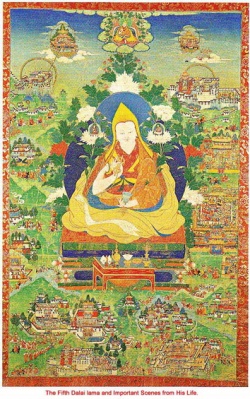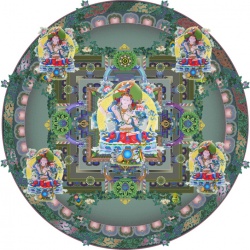Lamas and Nazis: The SS in Tibet--1938-39
Hitler and the Himalayas The SS Mission to Tibet 1938-39 ALEX McKAY
Of all the exotic images that the West has ever projected onto Tibet, that of the Nazi expedition, and its search for the pure remnants of the Aryan race, remains the most bizarre.
On the nineteenth of January, 1939, five members of the Waffen-SS, Heinrich Himmler's feared Nazi shock troops, passed through the ancient, arched gateway that led into the sacred city of Lhasa. Like many Europeans, they carried with them idealized and unrealistic views of Tibet, projecting, as Orville Schell remarks in his book Virtual Tibet, "a fabulous skein of fantasy around this distant, unknown land." The projections of the Nazi expedition, however, did not include the now familiar search for Shangri-La, the hidden land in which a uniquely perfect and peaceful social system held a blueprint to counter the transgressions that plague the rest of humankind. Rather, the perfection sought by the Nazis was an idea of racial perfection that would justify their views on world history and German supremacy.
What brings about this odd juxtaposition of Tibetan lamas and SS officers on the eve of World War II is a strange story of secret societies, occultism, racial pseudo-science, and political intrigue. They were, in fact, on a diplomatic and quasi-scientific mission to establish relations between Nazi Germany and Tibet and to search for lost remnants of an imagined Aryan race hidden somewhere on the Tibetan plateau. As such, they were a far-flung expression of Hitler's most paranoid and bizarre theories on ethnicity and domination. And while the Tibetans were completely unaware of Hitler's racist agenda, the 1939 mission to Tibet remains a cautionary tale about how foreign ideas, symbols, and terminology can be horribly misused. Some Nazi militarists imagined Tibet as a potential base for attacking British India, and hoped that this mission would lead to some form of alliance with the Tibetans. In that they were partly successful. The mission was received by the Reting Regent (who had led Tibet since the death of the Thirteenth Dalai Lama in 1933), and it did succeed in persuading the Regent to correspond with Adolf Hitler. But the Germans were also interested in Tibet for another reason. Nazi leaders such as Heinrich Himmler believed that Tibet might harbor the last of the original Aryan tribes, the legendary forefathers of the German race, whose leaders possessed supernatural powers that the Nazis could use to conquer the world.
This was the age of European expansion, and numerous theories provided ideological justification for imperialism and colonialism. In Germany the idea of an Aryan or "master" race found resonance with rabid nationalism, the idea of the German superman distilled from the philosophy of friedrich Nietzsche, and Wagner's operatic celebrations of Nordic sagas and Teutonic mythology. Long before the 1939 mission to Tibet, the Nazis had borrowed Asian symbols and language and used them for their own ends. A number of prominent articles of Nazi rhetoric and symbolism originated in the language and religions of Asia. The term "Aryan", for example, comes from the Sanskrit word arya, meaning noble. In the Vedas, the most ancient Hindu scriptures, the term describes a race of light-skinned people from Central Asia who conquered and subjugated the darker-skinned (or Dravidian) peoples of the Indian subcontinent. Linguistic evidence does support the multidirectional migration of a central Asian people, now referred to as Indo-Europeans, into much of India and Europe at some point between 2000 and 1500 B.C.E., although it is unclear whether these Indo-Europeans were identical with the Aryans of the Vedas.
So much for responsible scholarship. In the hands of late nineteenth- and early twentieth-century European jingoists and occultists such as Joseph Arthur de Gobineau, these ideas about Indo-Europeans and light-skinned Aryans were transformed into a twisted myth of Nordic and later exclusively German racial superiority. The German identification with the Indo-Europeans and Aryans of the second millennium B.C.E. gave historical precedence to Germany's imperial "place in the sun" and the idea that ethnic Germans were racially entitled to conquest and mastery. It also aided in fomenting anti-Semitism and xenophobia, as Jews, Gypsies, and other minorities did not share in the Aryan German's perceived heritage as members of a dominant race. Ideas about an Aryan or master race began to appear in the popular media in the late nineteenth century. In the 1890s, E. B. Lytton, a Rosicrucian, wrote a best-selling novel around the idea of a cosmic energy (particularly strong in the female sex), which he called "Vril." Later he wrote of a Vril society, consisting of a race of super-beings that would emerge from their underground hiding-places to rule the world. His fantasies coincided with a great interest in the occult, particularly among the upper classes, with numerous secret societies founded to propagate these ideas. They ranged from those devoted to the Holy Grail to those who followed the sex and drugs mysticism of Alastair Crowley, and many seem to have had a vague affinity for Buddhist and Hindu beliefs.
Members of the German SS expedition. Inner circle, left to right: Krause, Wienert, Beger, Geer, Schaefer. photo courtesy Alex McKay
General Haushofer, a follower of Gurdjieff and later one of Hitler's main patrons, founded one such society. Its aim was to explore the origins of the Aryan race, and Haushofer named it the Vril Society, after Lytton's fictional creation. Its members practiced meditation to awaken the powers of Vril, the feminine cosmic energy. The Vril Society claimed to have links to Tibetan masters, apparently drawing on the ideas of Madame Blavatsky, the Theosophist who claimed to be in telepathic contact with spiritual masters in Tibet. In Germany, this blend of ancient myths and nineteenth-century scientific theories began to evolve into a belief that the Germans were the purest manifestation of the inherently superior Aryan race, whose destiny was to rule the world. These ideas were given scientific weight by ill-founded theories of eugenics and racist ethnography. Around 1919, the Vril Society gave way to the Thule Society (Thule Gesellschaft), which was founded in Munich by Baron Rudolf von Sebottendorf, a follower of Blavatsky. The Thule Society drew on the traditions of various orders such as the Jesuits, the Knights Templar, the Order of the Golden Dawn, and the Sufis. It promoted the myth of Thule, a legendary island in the frozen northlands that had been the home of a master race, the original Aryans. As in the legend of Atlantis (with which it is sometimes identified), the inhabitants of Thule were forced to flee from some catastrophe that destroyed their world. But the survivors had retained their magical powers and were hidden from the world, perhaps in secret tunnels in Tibet, where they might be contacted and subsequently bestow their powers on their Aryan descendants.
Such ideas might have remained harmless, but the Thule Society added a strong right-wing, anti-Semitic political ideology to the Vril Society mythology. They formed an active opposition to the local Socialist government in Munich and engaged in street battles and political assassinations. As their symbol, along with the dagger and the oak leaves, they adopted the swastika, which had been used by earlier German neo-pagan groups. The appeal of the swastika symbol to the Thule Society seems to have been largely in its dramatic strength rather than its cultural or mystical significance. They believed it was an original Aryan symbol, although it was actually used by numerous unconnected cultures throughout history. Beyond the adoption of the swastika, it is difficult to judge the extent to which either Tibet or Buddhism played a part in Thule Society ideology Vril Society founder General Haushofer, who remained active in the Thule Society, had been a German military attache in Japan. There he may have acquired some knowledge of Zen Buddhism, which was then the dominant faith among the Japanese military. Other Thule Society members, however, could only have read early German studies of Buddhism, and those studies tended to construct the idea of a pure, original Buddhism that had been lost, and a degenerate Buddhism that survived, much polluted by primitive local beliefs. It seems that Buddhism was little more than a poorly understood and exotic element in the Society's loose collection of beliefs, and had little real influence on the Thule ideology. But Tibet occupied a much stronger position in their mythology, being imagined as the likely home of the survivors of the mythic Thule race.
Here an SS anthropologist measures a Tibetan woman's head. Some German scientists believed that Aryan features were reflected in the dimensions of the skull. (C)Transmit Films GMBH
The importance of the Thule Society can be seen from the fact that its members included Nazi leaders Rudolf Hess (Hitler's deputy), Heinrich Himmler, and almost certainly Hitler himself. But while Hitler was at least nominally a Catholic, Himmler enthusiastically embraced the aims and beliefs of the Thule Society. He adopted a range of neo-pagan ideas and believed himself to be a reincarnation of a tenth-century Germanic king. Himmler seems to have been strongly attracted to the possibility that Tibet might prove to be the refuge of the original Aryans and their superhuman powers. By the time Hitler wrote Mein Kampf in the 1920s, the myth of the Aryan race was fully developed. In Chapter XI, "Race and People," he expressed concern over what he perceived as the mixing of pure Aryan blood with that of inferior peoples. In his view, the pure Aryan Germanic races had been corrupted by prolonged contact with Jewish people. He lamented that northern Europe had been "Judaized" and that the German's originally pure blood had been tainted by prolonged contact with Jewish people, who, he claimed, lie "in wait for hours on end, satanically glaring at and spying on the unsuspicious girl whom he plans to seduce, adulterating her blood and removing her from the bosom of her people." For Hitler, the only solution to this mingling of Aryan and Jewish blood was for the tainted Germans to find the wellsprings of Aryan blood. It may happen that in the course of history such a people will come into contact a second time, and even oftener, with the original founders of their culture and may not even remember that distant association. A new cultural wave flows in and lasts until the blood of its standard-bearers becomes once again adulterated by intermixture with the originally conquered race. In the search for "contact a second time" with the Aryans, Tibet-long isolated, mysterious, and remote-seemed a likely candidate.


